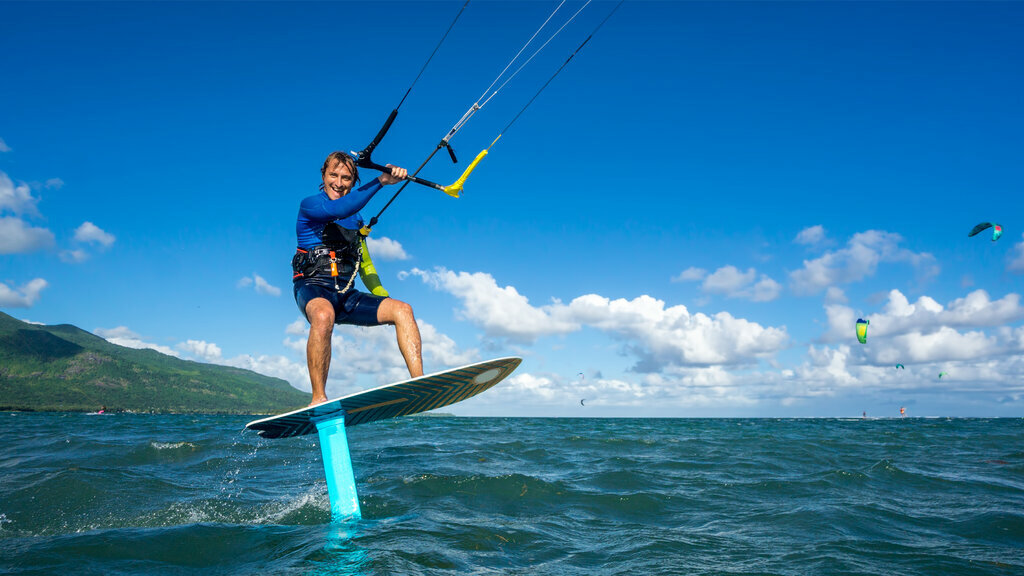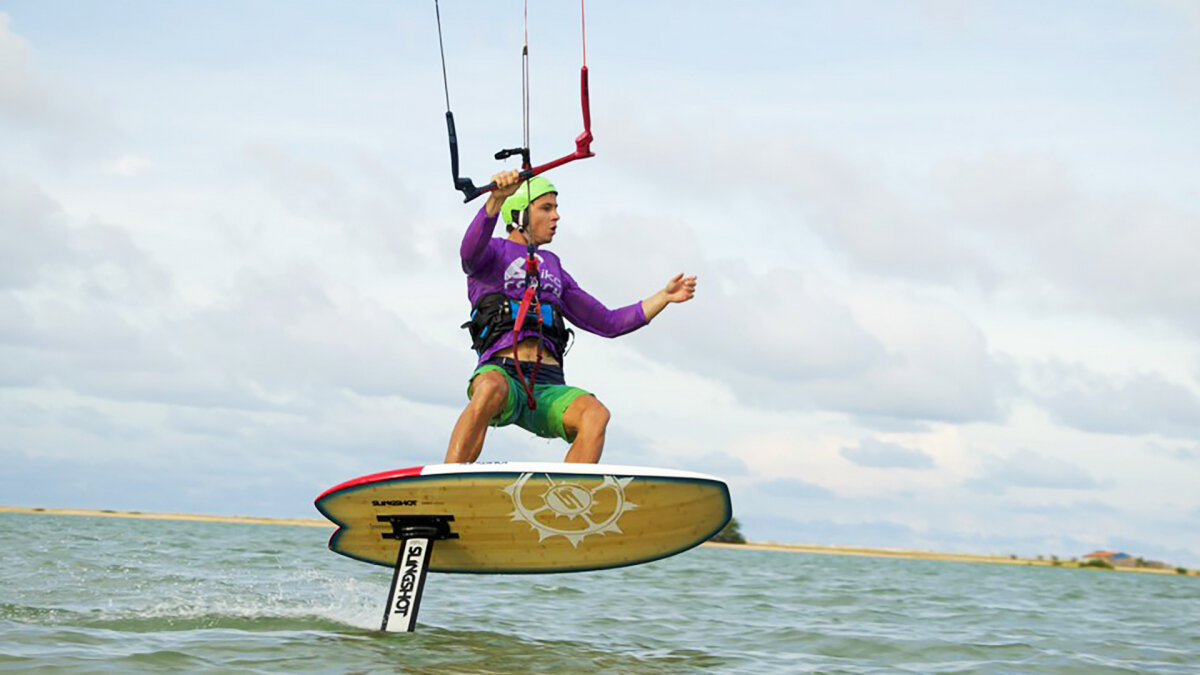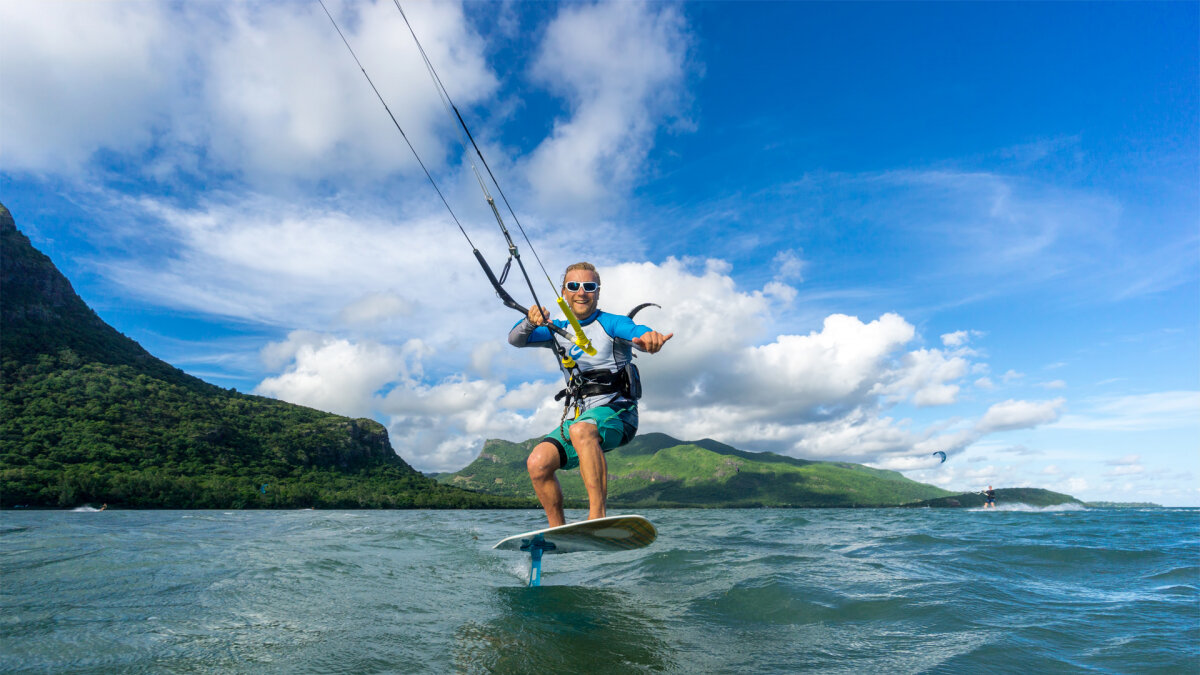Try the new IKO website at https://beta.ikointl.com/

Teaching to Ride on a Hydrofoil? Here Are Some Tips for Instructors
Hydrofoiling can be intimidating at first, but with these teaching tips, we can take some of the stress out of the learning process and make it an enjoyable experience for both you, the instructor, and your student. As an IKO Assistant Trainer and manager of the IKO Center Strong Kiteboarding (Canada), here are my personal tips to teach hydrofoil successfully.
The very first thing you need to do is talk to your students to find out about their previous kiting experience and what their goals will be. If the student can ride a strapless board and perform gybes and tacks, that’s a good starting point. It is not a necessary skill, but it is a big help as the balance required to gybe/tack is an important stepping stone towards foil balance. I often suggest to some of my potential foil clients to come back after more practise because they lack the kite control and board skills required to use a hydrofoil.
What Is The Right Size of Kite to Teach Hydrofoiling?
The right size of kite is critical to learn (and teach) how to foil. On one hand, a kite too large and the student will be overpowered as soon as the foil lifts. On the other hand, a kite too small and the student will be struggling and have an even harder time with the foil. The key point is that the student should not be struggling to keep the kite in the air. I personally recommend the smallest kite that the student could ride a twintip in for the current conditions.
For teaching, I look for:
- 14-18kts wind speed - A good range for safety and kite control. I personally won’t teach beginners over 20kts.
- 8-12m Kite - Big kites are very slow and small kites can be too fast. This can be altered by changing the length of the lines.
- Shorter lines - We don’t need a lot of power so 20m or less can be used. Some racers even go down to 12m lines.
- Steady wind - Makes kite control much easier.
- Flatwater - Flatwater or small chop is what we look for because big swell or waves make things much harder.
- For a 75kg student - 10m kite with 18m lines and 14-16kts is usually perfect.
What Board Should You Use to Teach Hydrofoil?
A teaching board will be different than a board that a confident rider will use. Racers enjoy long skinny boards while freestylers often like the smallest they can get their hands (or feet) on.
For teaching, I prefer:
- Wider boards with lots of surface area - More stability!
- Large volume on the board - More balance.
- Loose straps in the forward-most position - Easier to get in and out.

My Recommended Foil and Mast for a Smoother Progression
A short mast is an instructor’s greatest tool and a student’s best friend. Masts come in many lengths but I personally choose a custom 50cm (20”) mast for teaching. I find with shorter masts the students progress faster than with a full-length mast, which can be intimidating at first (and more risky during a crash).
Foil wings come in many different shapes and sizes and have similar properties to kites. Big wings lift at very low speeds and small wings are built for speed but inherently unstable.
For teaching, I suggest:
- A short mast around 38-61cm (15-24”) - Much safer and easier to ride.
- Mast in the rear position (as far as it goes on many boards) - less prone to lifting early and more forgiving with rear foot pressure.
- Medium size and aspect wing - Does not lift too early but still has good stability.
The Lesson Plan to Teach Kitesurfing on a Hydrofoil
The first thing I do with my student is sit down and take the time to analyze the board. We go over the proper way to carry the board, how to enter the water and what to do to make sure the student keeps control of the board.
To begin with, I tell the student to:
- Enter the water with the board but without the kite - Good practice to get the board on and off and I remind them “DO NOT KICK” (the trailing edge of the foil is sharp and can cause lacerations when kicked).
- Tilt the board so the mast is parallel to the water - Much easier position to put the board on.
- Enter the water and body drag out 3+ line lengths from the shore in order to get a good buffer zone.
- Do not try to save any near-crashes - Just ditch the board and get away from it! At this stage, trying to save it is not likely nor safe.
The student will then put the board on and do a steady pull (same as with a twintip). When they are confident with that manoeuvre, we are ready to try a water-start.
To perform a water-start on a hydrofoil, my tips are:
- Get up on the upstroke of the kite - This will aid in balance and keep the speed down.
- Emphasize that “slow and steady” is best - Keep the speed down, an upright body position and a flat board on the water.
- Many people will struggle at this stage as it is pretty much counterintuitive to all the other kiting skills they have learned.
- Put the rear foot in front of the back foot strap (if using one) - This aids in balance and for getting away from the board in a crash.
- Only rotate along the yaw axis (in line with the mast) - Keep all the movements in one dimension, no pitching or rolling (heel edge or tail pressure).
When your student reaches the riding stage, it is important to keep the speed down and the foil low.
- Push the bar - The bar will act as an elevator, push it out to go down and low.
- Don’t lean back - When the board first lifts there is a strong urge to lean back, but tell your student not to. This can be difficult for the student and takes practice.
- Front foot pressure - Push that foil back down!
- Don’t foil for now! - Make sure your student keeps the board on the water until he or she can ride consistently 100+ meters in both directions. They will still feel the foil below them, but the board acts like training wheels.

Riding the Foil and Getting Lifted!
Now it is time for some exciting fun! If your student has the proper body position (upright without bent hips or knees) then the foil will lift on its own just from speed and waves. I encourage the student to increase speed until the foil starts to lift, then push it back down with the front foot. Once we get to this stage, make sure your student…
- Keeps a steady speed and increases it slowly - We don’t want drastic speed or direction changes.
- Lets the board lifts as it goes over a small piece of chop - Then land back on the next wave.
- Pumps the back foot - Once some foiling has been achieved, you can suggest a bit of rear foot pumping to aid in lifting.
- Keeps the foil low overall- Steady height control is a required skill and much safer.
With training, practice and coaching, your students will get more and more confidence. Your student can now...
- Start foiling over 2-3 waves but keeps the foil low and at a steady height.
- Go for longer rides - Starts riding the foil itself, not just bouncing between waves.
- Keep a steady foil height - Uses the bar and foot pressure to control this.
- Control the speed - The position of the kite, bar and direction of the board are used.
- Focus on the direction - Rotating along the same axis as the mast and try not to lean or edge (heel or tail pressure).
When the student is at this stage they are almost ready to try on their own. The next steps will be…
- Riding the foil higher - Get up to mid foil height and keep it steady.
- Riding upwind - While foiling, rotate along the yaw axis to turn upwind.
- Introducing pitch and roll - When the student can turn with control on one of the axes, we can introduce the other axes. Heel pressure to head upwind at a better angle and using foot pressure to lift the board along with speed.
Finishing up a Foiling Lesson
Most lessons end typically after 2-3 hours. The student will usually rent the short mast for a few more hours (if their level is sufficient) or move directly to a long mast. The same concepts apply when using a long mast, but they now have those skills under their belt.
Students will often come back after a few weeks/months of practice to learn gybing and tacking. With all of your own foiling practice, you should be ready to teach your students these advanced skills too.
For a more in-depth understanding of hydrofoil (and how to teach it properly), make sure to check out our comprehensive Kiteboarder’s Handbook on Hydrofoil or watch our new hydrofoil video series available on the IKO website and the IKO App (available to Kiter Premium members and all valid IKO Instructors).
Author: Martin Dovick
.png)

